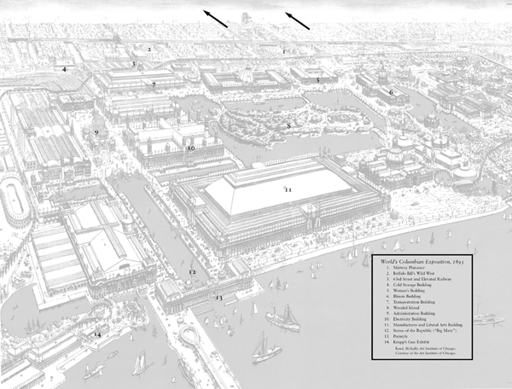
Chicago, 1891.


EVILS IMMINENT
(A NOTE)
IN CHICAGO AT THE END of the nineteenth century amid the smoke of industry and the clatter of trains there lived two men, both handsome, both blue-eyed, and both unusually adept at their chosen skills. Each embodied an element of the great dynamic that characterized the rush of America toward the twentieth century. One was an architect, the builder of many of America’s most important structures, among them the Flatiron Building in New York and Union Station in Washington, D.C.; the other was a murderer, one of the most prolific in history and harbinger of an American archetype, the urban serial killer. Although the two never met, at least not formally, their fates were linked by a single, magical event, one largely fallen from modern recollection but that in its time was considered to possess a transformative power nearly equal to that of the Civil War.
In the following pages I tell the story of these men and this event, but I must insert here a notice: However strange or macabre some of the following incidents may seem, this is
Beneath the gore and smoke and loam, this book is about the evanescence of life, and why some men choose to fill their brief allotment of time engaging the impossible, others in the manufacture of sorrow. In the end it is a story of the ineluctable conflict between good and evil, daylight and darkness, the White City and the Black.
ERIK LARSON
SEATTLE
DANIEL H. BURNHAM
DIRECTOR OF WORKS
WORLD’S COLUMBIAN EXPOSITION, 1893
DR. H. H. HOLMES
CONFESSION
1896
PROLOGUE

The architects
Aboard the
THE DATE WAS APRIL 14, 1912, a sinister day in maritime history, but of course the man in suite 63–65, shelter deck C, did not yet know it. What he did know was that his foot hurt badly, more than he had expected. He was sixty-five years old and had become a large man. His hair had turned gray, his mustache nearly white, but his eyes were as blue as ever, bluer at this instant by proximity to the sea. His foot had forced him to delay the voyage, and now it kept him anchored in his suite while the other first-class passengers, his wife among them, did what he would have loved to do, which was to explore the ship’s more exotic precincts. The man loved the opulence of the ship, just as he loved Pullman Palace cars and giant fireplaces, but his foot problem tempered his enjoyment. He recognized that the systemic malaise that caused it was a consequence in part of his own refusal over the years to limit his courtship of the finest wines, foods, and cigars. The pain reminded him daily that his time on the planet was nearing its end. Just before the voyage he told a friend, “This prolonging of a man’s life doesn’t interest me when he’s done his work and has done it pretty well.”
The man was Daniel Hudson Burnham, and by now his name was familiar throughout the world. He was an architect and had done his work pretty well in Chicago, New York, Washington, San Francisco, Manila, and many other cities. He and his wife, Margaret, were sailing to Europe in the company of their daughter and her husband for

